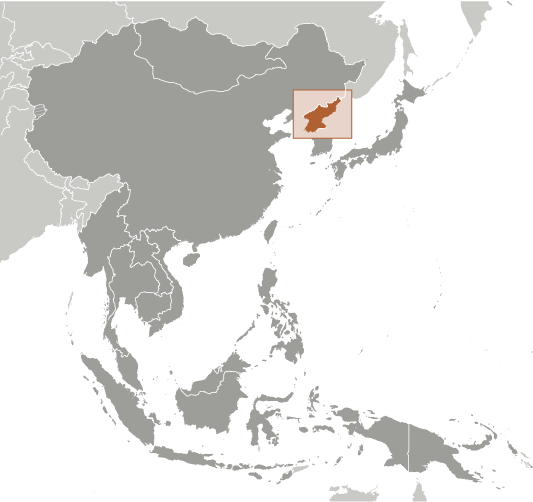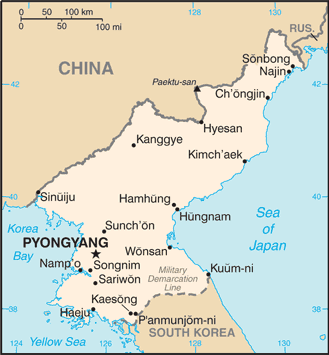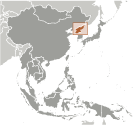
|
|
Advertisements:
GovernmentCountry name
Conventional long form
Democratic People's Republic of Korea Conventional short form North KoreaLocal long form Choson-minjujuui-inmin-konghwaguk Local short form ChosonAbbreviation DPRK Government type
Communist state one-man dictatorship Capital
Name Pyongyang
Geographic coordinates 39 01 N, 125 45 E Time difference UTC+9 (14 hours ahead of Washington, DC during Standard Time) Administrative divisions
9 provinces (do, singular and plural) and 2 municipalities (si, singular and plural) Provinces Chagang-do (Chagang), Hamgyong-bukto (North Hamgyong), Hamgyong-namdo (South Hamgyong), Hwanghae-bukto (North Hwanghae), Hwanghae-namdo (South Hwanghae), Kangwon-do (Kangwon), P'yongan-bukto (North P'yongan), P'yongan-namdo (South P'yongan), Yanggang-do (Yanggang) Municipalities Nason-si, P'yongyang-si (Pyongyang) Independence
15 August 1945 (from Japan)
National holiday
Founding of the Democratic People's Republic of Korea (DPRK), 9 September (1948) Constitution
Adopted 1948; revised several times Legal system
Civil law system based on the Prussian model; system influenced by Japanese traditions and Communist legal theory International law organization participation
Has not submitted an ICJ jurisdiction declaration; non-party state to the ICCt Suffrage
17 years of age; universal
Executive branch
Chief of state
KIM Jong Un (since 17 December 2011) note - the rubberstamp Supreme People's Assembly (SPA) reelected KIM Yong Nam in 2009 president of its Presidium also with responsibility of representing state and receiving diplomatic credentials Head of government Premier CHOE Yong Rim (since 7 June 2010); Vice Premiers: HAN Kwang Bok (since 7 June 2010), JO Pyong Ju (since 7 June 2010), JON Ha Chol (since 7 June 2010), KANG Nung Su (since 7 June 2010), KANG Sok Ju (since 23 September 2010), KIM In Sik (since 13 April 2012), KIM Rak Hui (since 7 June 2010), KIM Yong Jin (since 6 January 2012), PAK Su Gil (since 18 September 2009), RI Chol Man (since 13 April 2012), RI Mu Yong (since 31 May 2011), RI Sung Ho (since 13 April 2012), RO Tu Chol (since 3 September 2003) Cabinet Naegak (cabinet) members, except for Minister of People's Armed Forces, are appointed by SPA Elections Last election held in September 2003; date of next election NA Election results KIM Jong Il and KIM Yong Nam were only nominees for positions and ran unopposed Legislative branch
Unicameral Supreme People's Assembly or Ch'oego Inmin Hoeui (687 seats; members elected by popular vote to serve five-year terms) Elections Last held on 8 March 2009 (next to be held in March 2014) Election results Percent of vote by party - NA; seats by party - NA; ruling party approves a list of candidates who are elected without opposition; a token number of seats are reserved for minor parties Judicial branch
Central Court (judges are elected by the Supreme People's Assembly) Political parties and leaders
Major party - Korean Workers' Party or KWP [KIM Jong Il]; minor parties - Chondoist Chongu Party [RYU Mi Yong] (under KWP control), Social Democratic Party [KIM Yong Dae] (under KWP control) Political pressure groups and leaders
None
International organization participation
ARF, FAO, G-77, ICAO, ICRM, IFAD, IFRCS, IHO, IMO, IOC, IPU, ISO, ITSO, ITU, NAM, UN, UNCTAD, UNESCO, UNIDO, UNWTO, UPU, WFTU, WHO, WIPO, WMO Diplomatic representation in the us
None; North Korea has a Permanent Mission to the UN in New York Diplomatic representation from the us
None; note - Swedish Embassy in Pyongyang represents the US as consular protecting power Flag description
Three horizontal bands of blue (top), red (triple width), and blue; the red band is edged in white; on the hoist side of the red band is a white disk with a red five-pointed star; the broad red band symbolizes revolutionary traditions; the narrow white bands stands for purity, strength, and dignity; the blue bands signify sovereignty, peace, and friendship; the red star represents socialism National symbol(s)
Red star
National anthem
Name "Aegukka" (Patriotic Song)
Lyrics/music PAK Se Yong/KIM Won Gyun Note Adopted 1947; both North Korea and South Korea's anthems share the same name and have a vaguely similar melody but have different lyrics; the North Korean anthem is also known as "Ach'imun pinnara" (Let Morning Shine)
Comments
Add a new comment: |
Advertisement
Members area
North Korea (Pyongyang):
 
GPS points from North Korea (Pyongyang)
|
||||||||

 An independent kingdom for much of its long history, Korea was occupied by Japan beginning in 1905 following the Russo-Japanese War. Five years later, Japan formally annexed the entire peninsula. Following World War II, Korea was split with the northern half coming under Soviet-sponsored Communist control. After failing in the Korean War (1950-53) to conquer the US-backed Republic of Korea (ROK) in the southern portion by force, North Korea (DPRK), under its founder President KIM Il Sung, adopted a policy of ostensible diplomatic and economic "self-reliance" as a check against outside influence. The DPRK demonized the US as the ultimate threat to its social system through state-funded propaganda, and molded political, economic, and military policies around the core ideological objective of eventual unification of Korea under Pyongyang's control. KIM Il Sung's son, KIM Jong Il, was officially designated as his father's successor in 1980, assuming a growing political and managerial role until the elder KIM's death in 1994. KIM Jong Un was publicly unveiled as his father's successor in September 2010. Following KIM Jong Il's death in December 2011, the regime began to take actions to transfer power to KIM Jong Un and Jong Un has begun to assume his father's former titles and duties. After decades of economic mismanagement and resource misallocation, the DPRK since the mid-1990s has relied heavily on international aid to feed its population. North Korea's history of regional military provocations, proliferation of military-related items, long-range missile development, WMD programs including tests of nuclear devices in 2006 and 2009, and massive conventional armed forces are of major concern to the international community. The regime has marked 2012, the centenary of KIM Il Sung's birth, a banner year; to that end, the country has heightened its focus on developing its economy and improving its people's livelihoods.
An independent kingdom for much of its long history, Korea was occupied by Japan beginning in 1905 following the Russo-Japanese War. Five years later, Japan formally annexed the entire peninsula. Following World War II, Korea was split with the northern half coming under Soviet-sponsored Communist control. After failing in the Korean War (1950-53) to conquer the US-backed Republic of Korea (ROK) in the southern portion by force, North Korea (DPRK), under its founder President KIM Il Sung, adopted a policy of ostensible diplomatic and economic "self-reliance" as a check against outside influence. The DPRK demonized the US as the ultimate threat to its social system through state-funded propaganda, and molded political, economic, and military policies around the core ideological objective of eventual unification of Korea under Pyongyang's control. KIM Il Sung's son, KIM Jong Il, was officially designated as his father's successor in 1980, assuming a growing political and managerial role until the elder KIM's death in 1994. KIM Jong Un was publicly unveiled as his father's successor in September 2010. Following KIM Jong Il's death in December 2011, the regime began to take actions to transfer power to KIM Jong Un and Jong Un has begun to assume his father's former titles and duties. After decades of economic mismanagement and resource misallocation, the DPRK since the mid-1990s has relied heavily on international aid to feed its population. North Korea's history of regional military provocations, proliferation of military-related items, long-range missile development, WMD programs including tests of nuclear devices in 2006 and 2009, and massive conventional armed forces are of major concern to the international community. The regime has marked 2012, the centenary of KIM Il Sung's birth, a banner year; to that end, the country has heightened its focus on developing its economy and improving its people's livelihoods. 